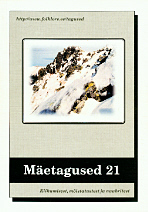Viru mees viljapulli, Harju mees aganapulli. Piirkondlike suhete kajastumisest eesti rahvatraditsioonis
The reflection of regional relations in Estonian folk tradition
Author(s): Mari-Ann RemmelSubject(s): Customs / Folklore
Published by: Eesti Kirjandusmuuseum
Summary/Abstract: The opposition of `self vs. the other' known from social psychology manifests itself vividly in ethnic group relations. Folklore, when associated with historical sources, enables us to look back and helps understand tensions discernible still present day. Historical names of tribes and counties no longer in use can either be lacking altogether from the collected folk tradition (e.g. Sakala, Rävala) or present themselves in toponyms (e.g. Uandimägi), runo songs (Ugala people as enemies, alutagune) and historical legends (Alutaguse people as wartime looters). Disappearing ethnonyms cannot be found from jokes, but they are related to certain folklore genres (various legends, runo songs). In contrast, ethnonyms/toponyms currently in use (incl. inhabitants of the ancient counties Virumaa, Harjumaa, Läänemaa and Saaremaa) occur frequently in genres that focus on humour. Historical legends tell about inter-tribal forays; short forms and nicknames can refer to hostile relationships. Sources of this kind regularly date back to the last decades of the 19th century when the folklore collection was started and disappear as Estonian patriotism (national self-determination) grew stronger. Traditional humorous folklore (various jokes and short forms) has been applied most actively by the inhabitants of Setumaa, Mulgimaa (former Sakala), Hiiumaa, Saaremaa and coastal regions - thus, the periphery. These areas provide many vivid descriptions of the nagging that takes place between boys or men from different smaller communities/dialect groups: parishes, townships and villages. This is present in various genres, fairly well represented also in the folklore of Võrumaa, Tartumaa, Harjumaa and Virumaa. The Central part of Estonia, Järvamaa, gives a somewhat lesser contribution. Neighbour humour with its classifications or subdivisions of ethnic groups or village inhabitants and explanations of these is characteristic to Western parts of Estonia, but lacking in the records of Võrumaa, Setumaa, Northern parts of Tartumaa, and Järvamaa. The best knowns today are the subdivisions of Hiiumaa inhabitants. This tradition is fairly similar to more archaic, alliterative and assonantal mockery listings that fall somewhere in between songs and figures of speech. Runo song has been one of the most ancient and influential forms of the `self vs. the other' opposition. The same function is performed by rhymed poems and songs. The present article discusses songs only briefly; the main analysis is devoted to other folklore genres. General impression is likely to be affected by the irregular and episodic collection practises; moreover, the earlier collection of folklore was based on genre divisions. The attitudes towards strangers are also reflected in beliefs: the inclusion of an individual among strangers creates the assumption that s/he is frightening (children threats) or possesses supernatural powers (e.g. the role of Setu or Hiiumaa people in some legends).
Journal: Mäetagused. Hüperajakiri
- Issue Year: 2003
- Issue No: 21
- Page Range: 141-192
- Page Count: 52
- Language: Estonian

